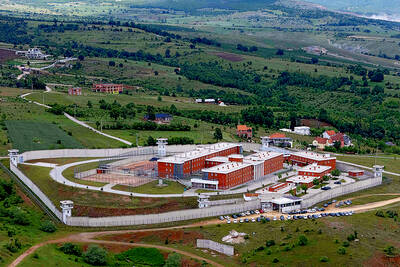On the eve of war, US President George W. Bush told the world that intelligence left no doubt Iraq had weapons of mass destruction. It was among the final assertions of an 18-month campaign by his administration to cast Iraqi President Saddam Hussein as a serious and imminent threat.
Six months later, there are doubts.
Last week, the CIA's chief weapons hunter, David Kay, told Congress: "We have not yet found stocks of weapons, but we are not yet at the point where we can say definitively either that such weapon stocks do not exist, or that they existed before the war and our only task is to find where they have gone."
On March 17, two days before the war, Bush said, "Intelligence gathered by this and other governments leaves no doubt that the Iraq regime continues to possess and conceal some of the most lethal weapons ever devised."
Kay presented an interim report Thursday that disclosed findings of his search teams. He argued against drawing final conclusions, saying he will be able to provide a full picture on Iraq's weapons programs in six to nine months.
So far Bush's prewar assertion is one of many that have not been validated by discoveries in Iraq.
A look at some:
Nuclear weapons
Vice President Dick Cheney, in a speech on Aug. 26 last year: "Simply stated, there is no doubt that Saddam Hussein now has weapons of mass destruction. There is no doubt he is amassing them to use against our friends, against our allies and against us."
Formal intelligence assessments were more conservative: "Although we assess that Saddam does not yet have nuclear weapons or sufficient material to make any, he remains intent on acquiring them. Most agencies assess that Baghdad started reconstituting its nuclear program about the time that [United Nations] inspectors depart -- December 1998," says the National Intelligence Estimate, or NIE, in October last year.
Kay: "Despite evidence of Saddam's continued ambition to acquire nuclear weapons, to date we have not uncovered evidence that Iraq undertook significant post-1998 steps to actually build nuclear weapons or produce fissile material."
Biological weapons
"The issue is that he's developing and has biological weapons," Cheney told CNN on March 24 last year.
The NIE, six months later: "We judge Iraq has some lethal and incapacitating BW agents and is capable of quickly producing and weaponizing a variety of such agents, including anthrax, for delivery by bombs, missiles, aerial sprayers and covert operatives. ... Baghdad has established a large-scale, redundant and concealed BW agent production capability."
Kay said his teams have uncovered evidence of what they interpret as a covert biological weapons development program, possibly centered in secret labs run by the Iraqi intelligence service. But he reported no signs any weapons were produced.
"Teams are uncovering significant information -- including research and development of BW-applicable organisms, the involvement of Iraqi Intelligence Service in possible BW activities and deliberate concealment activities. All of this suggests Iraq after 1996 further compartmentalized its program and focused on maintaining smaller, covert capabilities that could be activated quickly to surge the production of BW agents."
Chemical weapons
Before the war, the belief was widely held that Iraq had chemical weapons. Saddam had used them in the 1980s against Iranian troops in the eight-year Iran-Iraq war and against restive Iraqi Kurds.
"The issue is that he has chemical weapons, and he's used them," Cheney told CNN in March last year.
The NIE from last October said, "Although we have little specific information on Iraq's CW stockpile, Saddam probably has stocked at least 100 metric tons and possibly as much as 500 MT of CW agents -- much of it added in the last year."
Kay said on Thursday: "Our efforts to collect and exploit intelligence on Iraq's chemical weapons program have thus far yielded little reliable information on post-1991 CW stocks and CW agent production, although we continue to receive and follow leads related to such stocks. We have multiple reports that Iraq retained CW munitions made prior to 1991 ... but we have to date been unable to locate any such munitions."
Combat readiness of chemical weapons
Secretary of State Colin Powell, on Feb. 5 this year, told the UN: "We have sources that tell us that Saddam Hussein recently authorized Iraqi field commanders to use chemical weapons -- the very weapons the dictator tells the world he does not have."
Kay: "We have not yet found evidence to confirm prewar reporting that Iraqi military units were prepared to use CW against coalition forces."
chemical weapons production line
The NIE said: "We assess that Baghdad has begun renewed production of mustard, sarin, GF [cyclosarin] and VX; its capability probably is more limited now than it was at the time of the Gulf War, although VX production and agent storage life probably have been improved."
Kay: "Multiple sources with varied access and reliability have told [weapons search teams] that Iraq did not have a large, ongoing, centrally controlled CW program after 1991. Information found to date suggests that Iraq's large-scale capability to develop, produce and fill new CW munitions was reduced -- if not entirely destroyed."
Scud missiles
"Iraq also possesses a force of Scud-type missiles with ranges beyond the 150km permitted by the UN," Bush told the UN on Sept. 12 last year.
"[Iraq] retains -- in violation of UN resolutions -- a small number of Scud missiles that it produced before the Gulf War," CIA Director George Tenet told the Senate Intelligence Committee on Feb. 11 this year.
According to Kay: "One high-level detainee has recently claimed that Iraq retained a small quantity of Scud-variant missiles until at least 2001, although he subsequently recanted these claims. Work continues to determine the truth."
Longer-range missiles
Tenet: "Iraq ... is developing missiles with ranges beyond 1,000km."
True, Kay said: "The Iraqis were engaged in a very full-scale program that would have extended their delivery systems out beyond 1,000km."

By 2027, Denmark would relocate its foreign convicts to a prison in Kosovo under a 200-million-euro (US$228.6 million) agreement that has raised concerns among non-governmental organizations (NGOs) and residents, but which could serve as a model for the rest of the EU. The agreement, reached in 2022 and ratified by Kosovar lawmakers last year, provides for the reception of up to 300 foreign prisoners sentenced in Denmark. They must not have been convicted of terrorism or war crimes, or have a mental condition or terminal disease. Once their sentence is completed in Kosovan, they would be deported to their home country. In

Brazil, the world’s largest Roman Catholic country, saw its Catholic population decline further in 2022, while evangelical Christians and those with no religion continued to rise, census data released on Friday by the Brazilian Institute of Geography and Statistics (IBGE) showed. The census indicated that Brazil had 100.2 million Roman Catholics in 2022, accounting for 56.7 percent of the population, down from 65.1 percent or 105.4 million recorded in the 2010 census. Meanwhile, the share of evangelical Christians rose to 26.9 percent last year, up from 21.6 percent in 2010, adding 12 million followers to reach 47.4 million — the highest figure

A Chinese scientist was arrested while arriving in the US at Detroit airport, the second case in days involving the alleged smuggling of biological material, authorities said on Monday. The scientist is accused of shipping biological material months ago to staff at a laboratory at the University of Michigan. The FBI, in a court filing, described it as material related to certain worms and requires a government permit. “The guidelines for importing biological materials into the US for research purposes are stringent, but clear, and actions like this undermine the legitimate work of other visiting scholars,” said John Nowak, who leads field

LOST CONTACT: The mission carried payloads from Japan, the US and Taiwan’s National Central University, including a deep space radiation probe, ispace said Japanese company ispace said its uncrewed moon lander likely crashed onto the moon’s surface during its lunar touchdown attempt yesterday, marking another failure two years after its unsuccessful inaugural mission. Tokyo-based ispace had hoped to join US firms Intuitive Machines and Firefly Aerospace as companies that have accomplished commercial landings amid a global race for the moon, which includes state-run missions from China and India. A successful mission would have made ispace the first company outside the US to achieve a moon landing. Resilience, ispace’s second lunar lander, could not decelerate fast enough as it approached the moon, and the company has